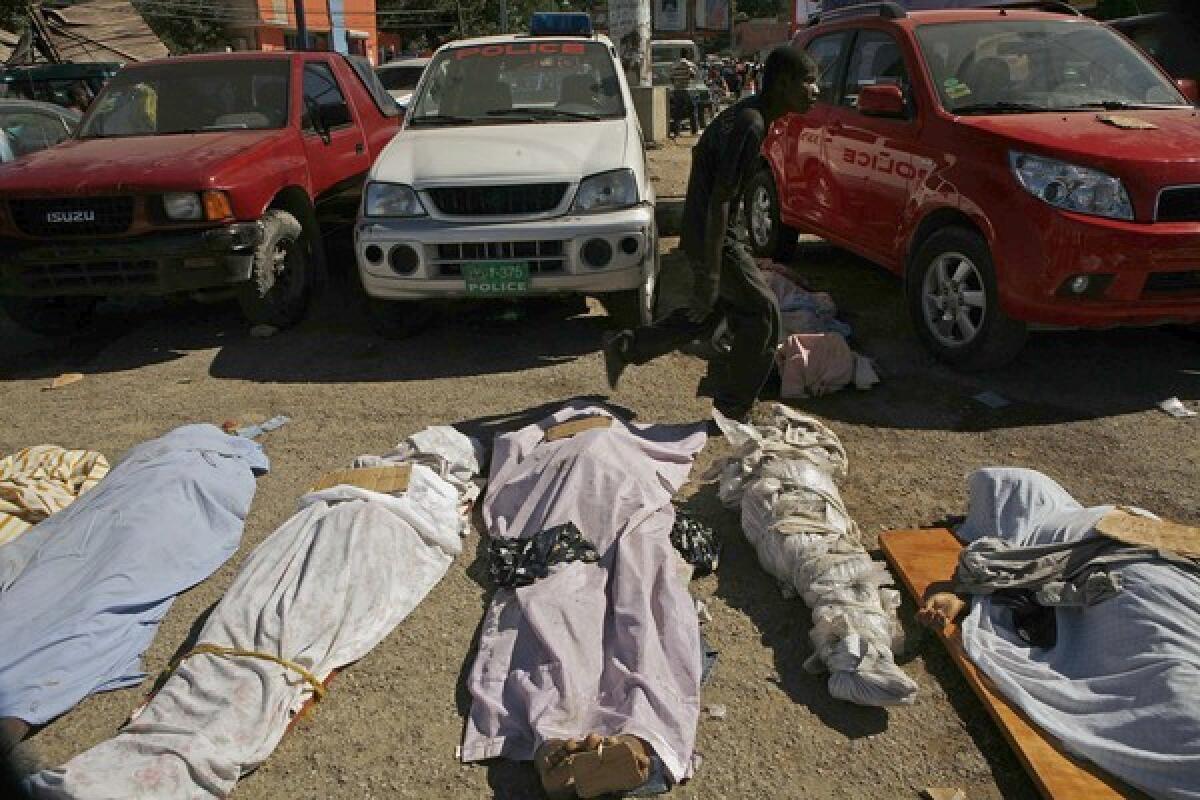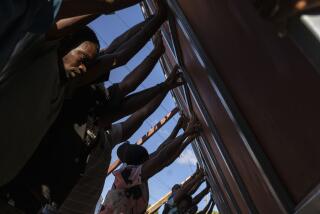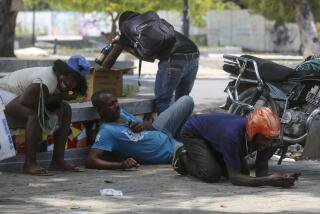Bodies lining Haiti’s roadsides are the grim tally of disaster

As darkness fell on Haiti’s capital Wednesday, crowds sought out the relative safety of the streets and open spaces.
In a hillside neighborhood just above downtown Port-au-Prince, they gathered under a spectacularly starry sky. And they sang. Like a huge school choir, earthquake survivors broke out in loud communal song, a soothing sound in a city with no power, little water and untold numbers of bodies hidden in rubble or strewn along the roadsides.
But the songs turned to screams as a strong aftershock hit, shaking the buildings that survived the magnitude 7.0 earthquake Tuesday and jolting the streets.
In moments, the crowd on the streets grew. Many of those who had risked remaining inside ran from their shaky shelters, away from the walls and ceilings that had caused such destruction a day earlier. People loitered, some looking at nearby buildings or collapsed walls.
Then the singing and chanting continued -- Catholic, Protestant, voodoo. “God, all of our hope is in you!” one man cried.
Across Port-au-Prince, the damage seemed nearly random.
Some homes covering hillsides looked as if they had simply crumbled into the dirt. Major government institutions and businesses were damaged or destroyed. Other buildings, such as the cheerful-looking Rose Restaurant, appeared untouched.
Officials could only guess at the number of dead and injured. Along the city’s roadsides, the bodies were neatly lined up, some covered in white sheets and some not.
The corpses included that of a girl, perhaps a teenager, in pink shorts; a couple lying next to each other; a man covered in a sheet save for his horribly swollen feet.
There was virtually no sign of outside assistance other than a few United Nations vehicles passing by. There was little police presence, no water being handed out, no encampments, except those set up by people apparently left homeless by the quake or those too afraid to go back into their ramshackle homes.
Tent and tarp cities sprang up wherever there was shade or open space. Virtually no shops were open, leaving residents in the street with no apparent means of finding food.
Outside the Canape Vert Hospital, a crowd surged toward the entrance. A few bodies covered with sheets lay nearby on the road. From the streets, choked with cars and pedestrians, one could hear a person screaming in the medical facility.
At the St. Esprit Hospital, a knot of people gathered at the gate seeking treatment for the injured.
“They take them out here because they can’t pay,” said Colas Enelson, 36.
Enelson said his pregnant wife had suffered broken legs. Neighbors had pulled her out of the rubble of their home.
Like other anxious relatives gathered at this spot and in the open around the city, he feared that she might die here, staring up at the stars.
Many of the injured had hideous wounds. Outside a makeshift Doctors Without Borders center a short walk from St. Esprit, one young woman, her foot impaled on a large wooden stake, lay on a refrigerator door being used as a stretcher.
A clearly harried worker in the guarded compound said there was no means to treat severely injured people. Only bandages and other equipment to provide basic care were available, the worker said.
The most formal kind of “triage” in plain sight was on the grounds of the once-lavish Villa Creole hotel, which had been turned into a makeshift outdoor hospital. The grounds were covered with injured: swollen, bloody limbs; crying children; others too weak or injured to make a sound.
“Ask him if he can wiggle his toes,” a man who appeared to be a doctor said to a woman as a young boy slumped in one of the hotel’s lounge chairs.
Some of the worst damage appeared to be in hillside neighborhoods such as Petionville, a suburb of the capital. People used sledgehammers and their bare hands to dig through a collapsed shopping center, tossing aside mattresses and office supplies, according to news reports. More than a dozen cars were entombed, including a U.N. truck.
Elsewhere in the capital, structures lay collapsed like giant sandwiches, with layer upon layer of concrete and remnants showing through: mattresses, shreds of clothing, chairs.
On the gentle hillside near downtown, two young women lay on mattresses with makeshift IVs supported by sticks and cinder blocks, apparently crafted by a nurse.
The brother of one of the women said a house had fallen on them.
Around the women, as night fell and the stars came out, the fearful and dispossessed settled down to sleep.
More to Read
Start your day right
Sign up for Essential California for news, features and recommendations from the L.A. Times and beyond in your inbox six days a week.
You may occasionally receive promotional content from the Los Angeles Times.








